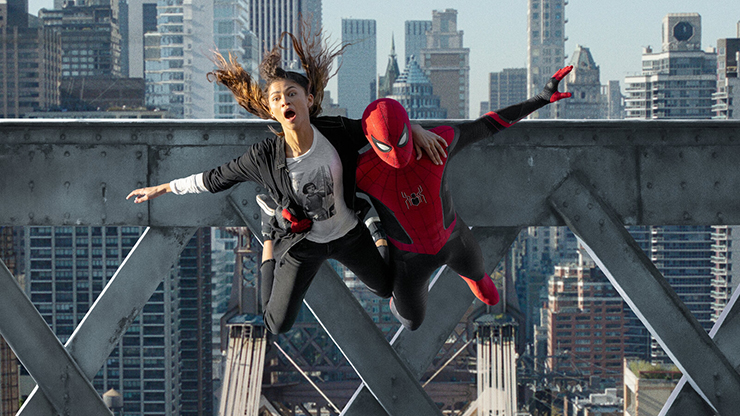
Zendaya and Tom Holland in a scene from "Spider-Man: No Way Home." Photo courtesy of Matt Kennedy/Sony Pictures.
It's a lazy, unimaginative addition to the zeitgeist, and yet people can't get enough of it. Whether you're sitting in the dark confines of your local multiplex, face mask safely in place, or vegging out on the couch decompressing from a busy day at work or enjoying a holiday break, one pop culture artifact's shout-out to a previous generation's pop culture artifact can and often does cause a frisson of pleasure. “I recognize this reference, and it makes me happy,” you unconsciously tell yourself.
Fan service has its place in our culture, but what happens when it becomes the driving force behind the handful of film releases that have connected with audiences over the past couple of months? Think of it as a laser pointer that guides fans like curious kittens from Point A to Point B. How much is too much? And what happens when its popularity comes at the expense of original work getting lost in the box office shuffle?
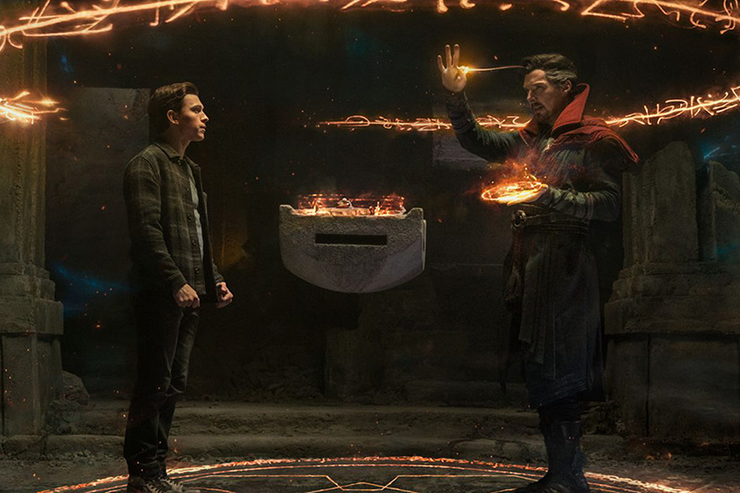
Tom Holland and Benedict Cumberbatch in a scene from "Spider-Man: No Way Home." Photo courtesy of Matt Kennedy/Sony Pictures.
This critic doesn't have an answer to that million-dollar question. Industry analysts much smarter than yours truly have written at length about the current state of movie going.
What I can say from my vantage point is this: there has to be more to a tent pole title than inserting tried-and-true content from prior decades in order to capture an audience's imagination. At the same time, those bemoaning this used and abused trend need to stop sounding the death knell for cinema. As significant and absolute as they may appear, these tendencies are cyclical. There is still a market, and an audience, for stimulating work geared toward grown-ups, at home and in an auditorium. Our job as surveyors of film art is to call attention to movies that would otherwise go overlooked, as well as to give credit where credit is due to those that do strike a chord with Joe Moviegoer.
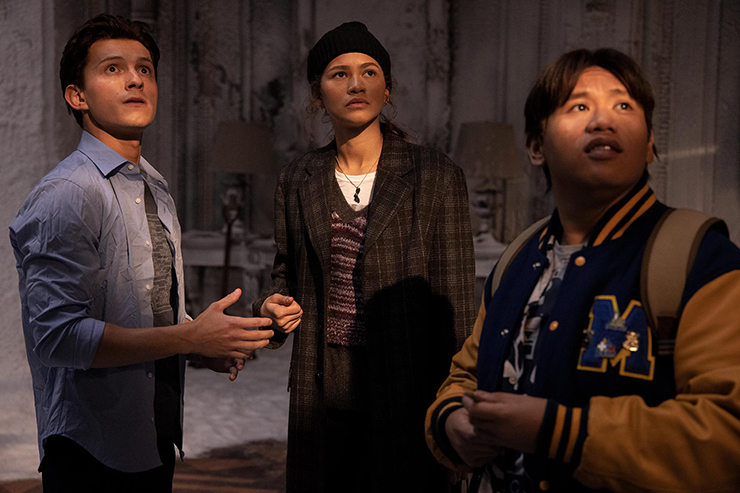
Tom Holland, Zendaya and Jacob Batalon in a scene from "Spider-Man: No Way Home." Photo courtesy of Matt Kennedy/Sony Pictures.
You probably think I'm about to trash three releases you may have seen and thoroughly enjoyed, but that's actually not the case. In fact, I found two of the three features I'm reviewing during these last days of 2021 to have explored fan service with moderately successful results. The third is an unmitigated disaster, so yes, in one instance I am giving you grief for finding enjoyment in something so irredeemably terrible. Somebody has to, right? Let's take the plunge.
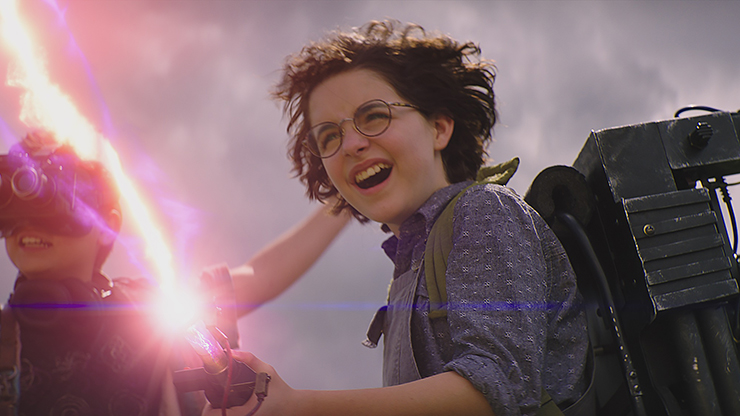
Mckenna Grace in a scene from "Ghostbusters: Afterlife." Photo courtesy of Sony Pictures.
“Spider-Man: No Way Home”: What can be said about a movie that attempts to poke fun at fan culture while simultaneously indulging in it? Pick a side, or get out of the way. And as the third entry in the Jon Watts-directed, Tom Holland-fronted Spidey saga opens, my eyes began rolling early and often. Here's what you need to know: At the end of Part 2, aka the globe-trotting “Spider Man: Far From Home,” attractive baddie/shyster Mysterio (Jake Gyllenhaal) yanked Peter Parker (Holland) out of the superhero closet for all the world to see.
“No Way Home” picks up immediately after that cliffhanger, as Peter and girlfriend/high school classmate MJ (Zendaya) frantically try to avoid the unforgiving glare of the spotlight that has suddenly fallen on the couple. The dizzying camera work in this opening sequence is actually an acceptable facsimile of the eye-popping visuals that set Sam Raimi's 2000s trilogy apart, even though elsewhere, cinematographer Mauro Fiore (“Avatar”) adopts the functional point-and-shoot style that gives MCU entries the dispiriting visual uniformity of long form TV.
The movie makes a big deal out of the newfound scrutiny for Peter and MJ (Holland and Zendaya, a couple in real life, display palpable chemistry), and its effect on Peter's best friend Ned (Jacob Batalon), Peter's aunt and guardian May (Marisa Tomei), and Happy (Jon Favreau), a holdover from the “Iron Man” movies and May's “it's complicated” companion. It gives Watts, working from a screenplay credited to Chris McKenna and Erik Sommers, an excuse to trot out the kind of franchise housekeeping that sets my teeth on edge. How about we stick with these characters are put the kibosh on the shoutouts to other ongoing (or past) MCU properties?
What actually kicks the story into gear this time is Parker's decision to seek the help of Dr. Stephen Strange (the ubiquitous Benedict Cumberbatch) to see if he can find a way to make people forget his identity in tights. Things don't go quite as planned, and Strange accidentally tears a hole in the space-time continuum media entities hold so near and dear. It doesn't take long for villains from past, Sony-produced incarnations of Spidey to make their destructive appearance and give Spidey a crimefighting workout.
If this alternate-reality turn rings a bell, you're probably thinking of “Spider-Man: Into the Spider-Verse,” the animated film that introduced Miles Morales as the newest Spidey and, for my money, remains one of the best superhero movies ever made. One of the many things that gives “Spider-Verse” the edge, in addition to its endless creativity, is its decision to use the multiverse to introduce lesser-known Spider-People, including Nicolas Cage's Spider-Man Noir. By contrast, Watts uses it to bring back familiar faces.

Photo courtesy of Sony Pictures.
LEFT: Paul Rudd in a scene from "Ghostbusters: Afterlife." Carrie Coon and Finn Wolfhard in a scene from "Ghostbusters: Afterlife."
And yet, something that at first glance might seem like the representation of everything that's wrong with the MCU ends up being “No Way Home's” saving grace.
For starters, while I normally frown upon making MCU movies a hybrid venture with other film series, the Doctor Strange crossover gives “No Way Home” much needed narrative juice. (It helps that Cumberbatch doesn't phone it in. He's having a good year.) It also enables Watts to make this entry a more character-driven portrait of Peter's trial-by-fire journey as a budding do-gooder.
And this attention to character development, involving Peter and others, is what helps guide “No Way Home” from being yet another uninspired sequel to morphing into a rather decent trilogy capper that justifies its nearly two-and-a-half-hour running time. To dig further into what makes the film better than its predecessors would entail going into spoiler territory, something I won't do here.
Suffice it to say that the surprises Marvel's marketing department has done such a poor job of hiding give way to some existential soul searching, some nifty meta content and a display of genuine affection for this webslinger that gives emotional heft to this uneven but disarming entry.
The last half hour in particular feels like a collective group hug, leading to a bittersweet moment of rare delicacy for this franchise. It won over this frequent MCU dissenter. The sentiment is cornball, but that doesn't make it any less resonant: sometimes love is all you need, and sometimes it isn't enough to save the day.
“Ghostbusters: Afterlife”: If “No Way Home” uses our generations-spanning attachment to a particular set of comic book characters to striking effect, this long-delayed legacy sequel, still going strong after more than a month out in theaters, lays bare the limitations of fan service. Let's rip off the Band-Aid; This valentine to Ivan Reitman's 1980s movies, directed by his son Jason and bolstered by the inclusion of some familiar faces in key cameo roles, is a dumpster fire, a poorly scripted excuse for family-friendly entertainment that wastes a talented cast and actually ends up paying homage to the wrong eighties content.
“Afterlife” trades in the Manhattan setting of previous “Ghostbusters” movies, including Paul Feig's almost-as-lousy 2016 reboot, for rural Oklahoma. (Alberta, Canada stands in for the Sooner State.) Single mom Callie (the esteemed Carrie Coon) uproots her kids Phoebe (Mckenna Grace) and Trevor (Finn Wolfhard) to the fictional town of Summerville to move into the dilapidated property she inherited from her deceased dad, ghostbuster Egon Spengler, played in the original movies by the late Harold Ramis.

Photo courtesy of Warner Bros. Pictures. Copyright:© 2021 Warner Bros. Entertainment Inc. and Village Roadshow Films North America Inc.
LEFT: Keanu Reeves in a scene from The Matrix Resurrections. Photo courtesy of Warner Bros.
RIGHT: Keanu Reeves and Yahya Abdul-Mateen II in a scene from The Matrix Resurrections.
Phoebe, resentful of her mother for, among other things, vilifying Egon as an absent father, soon discovers her grandfather's house is haunted. One discovery of a hidden paranormal activity lab later, she uncovers Egon was working on trapping a malevolent force that's angling for world domination, and it's linked to a mine located near a mountain that gives off heavy “Close Encounters” vibes.
It soon becomes clear that “Afterlife” is not aiming to recapture the sardonic irreverence of Ivan Reitman's 1984 comedy and its (slightly underrated) 1989 sequel. Instead, it looks to the films that helped make Steven Spielberg a household name for inspiration, something that the Netflix series “Stranger Things,” which stars Wolfhard, has done with mixed results.
But it gets what made those films special wrong, too. There is no sense of wonder or awe, no carefully staged moments of dread and peril. In its place are bad jokes, both intentional and unintentional, tired plotting and facile retreads of situations from the older “Ghostbusters” films. It also fails to take advantage of its small town setting. What kind of “Ghostbusters” movie includes destruction of property and doesn't see fit to introduce a corrupt mayor? Instead, we get a by-the-book sheriff (Bokeem Woodbine) who's saddled with reciting the line, “Who you gonna call?”
By this point, I wanted to throw something at the screen, and that's before a sequence inside of a Walmart introduces cute mini Stay-Puft Marshmallow Men. Jason Reitman, who's responsible for several noteworthy efforts behind the camera, including “Juno” and “Up in the Air,” has switched to sellout mode. He doesn't even bother to make the corporate branding interesting.
The sole bright spot is Paul Rudd, here playing a schoolteacher/seismologist who befriends Phoebe and asks Callie out on a date, at least when he's not monitoring some unusual activity. His easygoing charm is the only thing here that approximates the pleasures of the 1984 film. His “hip scientist” look, especially that well-groomed beard, is on point.
But nothing else is in this creative wasteland of a film that, perhaps worst of all, submits Coon's underwritten character to a number of indignities meant to be amusing but which are actually crass and demeaning. Then it changes gears and aims for the tear ducts, after it's done literally dragging the legacy of the first film through the dirt. The magnitude of the sheer awfulness of this inane waste of time cannot be overstated. It doesn't need your dollars; it needs an exorcism.
“The Matrix Resurrections”: On the opposite end of the throwback spectrum is this meta-to-the-max return to the sci-fi realm, created by siblings Lana and Lilly Wachowski, that helped change the face of the genre in the spring of 1999. The results this time are far from perfect, but this is without a doubt the most adventurous of these nostalgia trips.
The R-rated odyssey plays like a guided tour of the three prior “Matrix” movies masterminded by gender studies scholars intent in picking apart this binary universe (red pill vs. blue pill), then putting it back together in a way that grapples with its cultural footprint and where it goes from here. There is a lot to unpack here, and the exposition overload viewers are asked to untangle would have been deadly if the movie had taken itself as seriously as its predecessors.
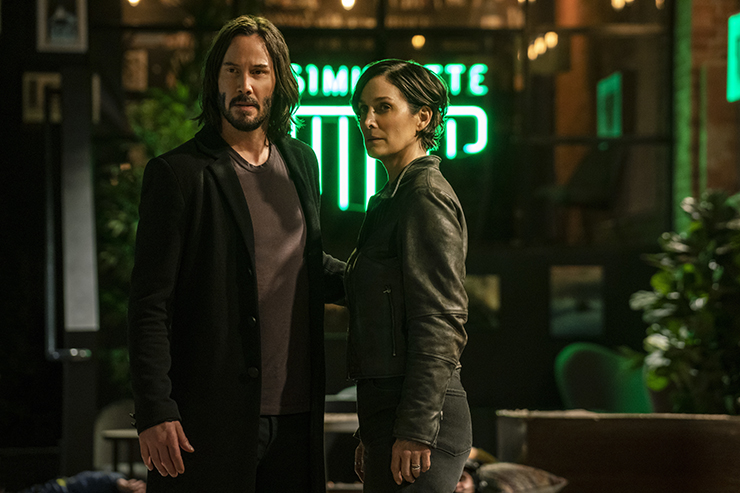
Keanu Reeves and Carrie-Anne Moss in a scene from The Matrix Resurrections. Photo Credit: Murray Close. Copyright:© 2021 Warner Bros. Entertainment Inc. and Village Roadshow Films North America Inc.
Fortunately, Lana Wachowski, here flying solo in the director's chair, is in a lighthearted mood, and one of her most valuable contributions is the levity and playful sense of humor she brings to the table. No kidding: several scenes, set at the aptly named Simulatte Coffee Shop, almost play like a rom-com.
“Resurrections” suggests what would have happened if Thomas Anderson (Keanu Reeves), aka Neo, had chosen to take the blue pill. It has lulled him into a virtual reality where he is a now middle-aged game designer in the middle of an identity crisis. A brainstorming session involving some work colleagues shows what Wachowski, working from a screenplay by novelists David Mitchell (“Cloud Atlas”) and Aleksandar Hemon (“Nowhere Man”), is after. Warner Bros. executives are name-dropped in the conversation, and not necessarily in a positive way. It basically uses the corporate greed behind a desire to make a “Matrix” sequel that people weren't exactly clamoring for as the impetus behind its deconstruction of the current crop of legacy sequels and reboots. Like Reeves himself would say, "whoa."
The film introduces a handful of new characters who appear to be trapped in the same noir-flavored scenarios from the first “Matrix,” but despite the confusing jargon and extended references to the sequels (“Reloaded” and “Revolutions”), the arc of “Resurrections” is right there in the title, and it very much centers on the black leather-clad Neo and Trinity (Carrie-Anne Moss), the yang to his yin.
Bugs (“Game of Thrones'” Jessica Henwick), one of the aforementioned new additions, finds Thomas, reminds him of the messianic figure he once was on the other side of this illusion he calls his life, and helps him cross paths with a man (“Candyman's” Yahya Abdul-Mateen II) who uncannily resembles his mentor Morpheus (played in the previous films by Laurence Fishburne). And once again he is presented with the choice: stay in his current, increasingly unsatisfying “reality,” or find out what is really going on.
Thomas/Neo takes the red pill, of course, and “Resurrections” goes back down the rabbit hole to revisit the influential technopunk iconography that fans of the “Matrix” trilogy hold in high regard. Some things are a little different, such as the color scheme cinematographers Daniele Massaccesi and John Toll opt for, but a lot of it will have you experiencing déjà vu, not always in good ways.
Where “Resurrections” falls short is in its fight sequences, which often look muddy and are way too choppy. But the emphasis here is not on the action, which is likely to disappoint fans wanting a slam-bang ride. Conceptually, though, the film never ceases to be intriguing. This is the work of a filmmaking team who have really thought out what they wanted to achieve, even though they are aware it's something with the capacity of alienating their fans. (It's called taking risks.) This is why you're seeing such polarizing reactions.
The film has prompted comparisons to “The Last Jedi,” another divisive trilogy entry met with anger by a section of a fanbase resentful of director Rian Johnson's willingness to break the mold in a way that doesn't align with their standards of what a “Star Wars” film should be like.
When it comes to “Resurrections,” I say more power to the wizards behind the curtain. They've pulled off something akin to what horror auteur Wes Craven did in “Wes Craven's New Nightmare,” a self-referential foray into the house that Freddy Krueger built where a lot of the most stimulating parts are in quotations.
That's not the whole story with “Resurrections.” Wachowski couples her intellectual pursuit with a sentimental romance that prevents the film from collapsing under the weight of its ambitions. The results are alternately brainy and goofy, inventive and trippy. With the inclusion of Jonathan Groff and Neil Patrick Harris in prominent supporting roles, it's also more in your face and less coded about its queerness than previous chapters. This is a layered text, one that invites and will benefit from repeat visits. Warts and all, it's a beacon of light in these uncertain times.
“Spider-Man: No Way Home,” “Ghostbusters: Afterlife” and “The Matrix Resurrections” are now showing in wide release across South Florida, including IMAX and Dolby Cinema engagements in select theaters for “Spider-Man” and “Resurrections.” For “No Way Home,” make sure to stay all the way to the end of the credits. “Resurrections” is also available to stream for the next month on HBO Max.




